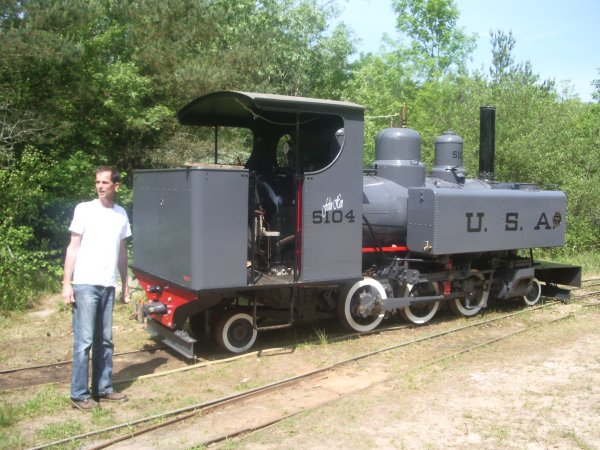|
|
Felin Hen Ex-Fairymead Mill, Bundaberg |
|

This photo is kindly provided by Ross Driver and shows
Felin Hen at Fairymead Mill in 1950, prior to conversion to 0-6-2T.
(Baldwin 10533 of 1899 is seen behind Felin Hen; this loco is also preserved
and is listed above.)
Generator mounted on the side tank, electric lighting
|
Builder |
Pennsylvania, USA |
|
Builder’s Number & Year |
46828 of 1917 |
|
Wheel Arrangement |
0-6-2T (originally 2-6-2T) |
|
This historic locomotive was built for the US Army
Transport Corps (USATC) during World War 1 to a standard design of 2-6-2T for
the network of 2’ gauge railways supplying the front line trenches. 195
examples of this type were built by Baldwin for the USATC, numbered 5001 –
5195; this surviving example was No.5104. The USATC adopted the 15-tonne
2-6-2T as a standard following similar locos produced by ALCO for the British
Army, with Baldwin, Davenport and Vulcan (USA) contracted to supply the type
to the US Army. Baldwin were noted for their speedy delivery and only the
Baldwin locos were delivered to the USATC in time for battlefield use; two
remained in the USA and another two were lost at sea (probably falling to
U-boat attack on shipping) while the remaining 191 saw service with the U.S.
Army in France. Interestingly, the last of the Baldwin batch (No.5195) was
sent to Davenport Locomotive Works as a pattern for their production of the
design. In France these
locomotives operated in grey livery with black smoke boxes, essentially
‘works grey’ and exemplifying the utilitarian nature of these war machines
with short life expectancy (exactly like the brutal conditions the soldiers
encountered). Large
numbers of 2’ gauge steam locomotives were available as war surplus materiel
at the end of WW1 hostilities, with many finding further use with various
light railways and industrial concerns around the world. No.5104 was one of
three sold to the Penrhyn slate quarries in North Wales, where it received
the name No.2 'Felin Hen' (which means 'Old Mill' in Welsh). The Penryn
quarry railway was 1’ 10 3⁄4“ gauge (578 mm) so presumably the
wheelsets were narrowed from 2’ gauge (610mm). Apparently
USATC No.5014 was not well suited to Penrhyn’s requirements and it was
subsequently sold to the Fairymead Mill in Queensland. (The two sister USATC
locomotives No.1 ‘Llandegai’ & No.3 ‘Tregarth’ where scrapped at Penryn
in 1940). The loco was shipped to Brisbane in 1940 and converted to 2' gauge,
becoming No.4 at Fairymead Mill, Bundaberg, although the name ‘Felin Hen’ was
retained. The loco was rebuilt to 0-6-2T in 1956 by removing the front pony
truck, which had often derailed on the Fairymead Mill system. New side tanks
of a different design were also fitted. No.4 Felin
Hen was withdrawn from service at Fairymead Mill in 1965 and plinthed in a
South Bundaberg park in 1969. It was later removed for restoration by the
Bundaberg Steam Tramway Preservation Society (BSTPS) and dismantled.
Unfortunately the loco was found to require extensive (and expensive)
rebuilding which was beyond the resources of the BSTPS at that time. Following
approaches by a French preservation group around June 2002, the BSTPS sold
No.4 Felin Hen for restoration to its original World War 1 form for operation
at the Tacot des Lacs
railway near Nemours, France. Felin Hen arrived at its French restoration
site in July 2002, joining a collection that includes several other World War
1 trench railway locomotives and related railway equipment from several
nations. By January
2011 the restoration of Felin Hen was complete, and the locomotive returned
to operation in 2-6-2T form, wearing authentic USATC grey livery. |

|
Felin Hen in her later 0-6-2T configuration, hauling whole stick cane at Fairymead Mill in the late 50's / early 60's. |

|
Felin Hen as restored in France, dated May 2011. The loco has been restored to original
2-6-2T configuration with riveted water tanks of original design, and wearing
USATC grey livery. The name ‘Felin Hen’ appears in white paint above the
number 5104 on the cabside. |
References
|
a |
Light
Railway Research Society of Australia Inc. Web site, |
|
b |
Wikipedia
page for Baldwin Locomotive Works, |
|
c |
'Light
Railways - Australia's Magazine of Industrial & Narrow Gauge Railways', Number 166, August 2002 (Page 28) published by
Light Railway Research Society of Australia Inc. |
|
d |
Wikivisual page for Trench
Railways |
|
e |
Information
sheet provided by the Bundaberg Steam Tramway Preservation
Society (BSTPS) and comments from discussions with members
during my visit of 26 & 27
December 2004. |
|
f |
Wikipedia
page for Penrhyn Quarry Railway, retrieved 30 June 2018. |
|
g |
Tacot des Lacs website, retrieved 1 February 2021 |
Page updated: 1 February 2022
|
Government Railways: |
|
|||||||||
|
Private & Industrial Railways: |
|